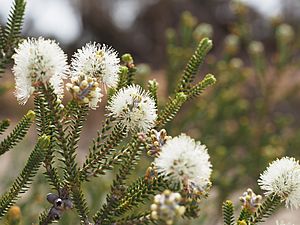Limestone honey-myrtle facts for kids
Quick facts for kids Limestone honey-myrtle |
|
|---|---|
 |
|
| M. quadrifaria leaves, flowers and fruit | |
| Scientific classification | |
| Genus: |
Melaleuca
|
| Species: |
quadrifaria
|
Melaleuca quadrifaria, also known as the limestone honey-myrtle, is a plant from the Myrtaceae family. It grows naturally in the southern parts of Western Australia. You can recognize it by its small leaves and tiny white or cream flowers.
Contents
What Does Limestone Honey-Myrtle Look Like?
Melaleuca quadrifaria is usually a large shrub. It can grow up to 5 m (20 ft) tall. This plant often has dark, tough bark. Sometimes, its bark can be grey or brown and papery.
Leaves and Branches
Its leaves are quite small. They are arranged in a special way on the branches. The leaves grow in pairs, with each pair at a right angle to the one above and below it. This creates four neat rows along the branches.
Each leaf is about 2.5–6.7 mm (0.1–0.3 in) long. They are also 0.8–1.5 mm (0.03–0.06 in) wide. The leaves are narrow and oval-shaped. If you cut one in half, it would look like a half-moon. They usually end in a blunt or rounded tip.
Flowers and Fruit
The flowers of the limestone honey-myrtle are white or cream colored. They grow in small clusters or spikes on the sides of the branches. These flower spikes can be up to 18 mm (0.7 in) across. Each spike has 2 to 9 groups of flowers, with three flowers in each group.
The plant's stamens, which are part of the flower, are grouped into five bundles. Each bundle has 9 to 13 stamens. This plant mostly flowers during the summer. After flowering, it produces small, round, woody fruits. These fruits are called capsules. They are about 2.5–3 mm (0.098–0.12 in) long. The capsules have a star-shaped opening and can be found scattered or in small groups along the stems.
How It Got Its Name
The plant Melaleuca quadrifaria was first officially described in 1886. This was done by a scientist named Ferdinand von Mueller. He wrote about it in a publication called "Southern Science Record".
Meaning of the Name
The second part of its name, quadrifaria, comes from Latin words. "Quattuor" means "four," and "-farius" means "-fold." This name refers to how the leaves are arranged in "four-fold" rows along the branches.
Where Limestone Honey-Myrtle Grows
This melaleuca plant is found in a wide area of Australia. It grows from the Newdegate area in Western Australia. Its range extends east all the way to the border with South Australia.
Natural Home
You can find it in places like Fraser Range Station, Cape Arid National Park, and Balladonia. It lives in different natural areas, including the Coolgardie, Hampton, Mallee, and Nullarbor Plain regions. This plant prefers to grow in clay, sand, and loamy soils. These soils are usually found over limestone on flat lands and near salt lakes.
Protecting the Species
The limestone honey-myrtle is a common plant in the areas where it grows. The Government of Western Australia's Department of Parks and Wildlife has looked at its numbers. They have classified it as "not threatened." This means it is not currently in danger of disappearing.
Uses of the Plant
Gardening and Landscaping
While not the most colorful plant, the limestone honey-myrtle is very useful. It makes a good shrub for dry areas. It especially thrives in places with limestone soils.
Special Oils
The leaves of Melaleuca quadrifaria contain important essential oils. One of these oils is called 1,8-cineole, also known as Eucalyptol.
Images for kids
-
M. quadrifaria growing near the Scaddan Road



